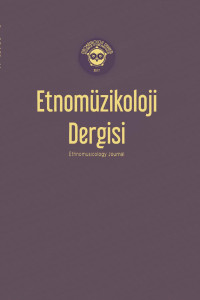Öz
Theoretical works on blues as a style in its own right are scarce. Within the rather compact corpus
of theoretical works on blues, only very few authors have attempted the establishment of a
comprehensive theory, i.e., a theory that would account for the majority of phenomena exhibited by
the vast array of musical styles that have come to be called blues at a certain point in time. A
comprehensive definition of blues in the sense of a common theory applicable to the majority of its
musical exponents has therefore hitherto not been satisfactorily established. Considering the totality
of its sub-styles, blues is a highly diverse style and thus defies definition through a theory based on
the analysis of physical musical constituents. In the article, I attempt to formulate a comprehensive
definition and theory of blues; the definition and theory is based on the fact that blues shares
common traits with Pidgin languages, which can be uncovered by an understanding of how blues
uses the harmonic and melodic language of Western tonal music. The article analyzes the
decontextualized use of Western tonal elements in blues through Schenkerian and tonal analysis,
and compares the findings to three traits of Pidgin languages, namely limited embedding and
avoidance of deeper structure, the use of infinitive forms and metonymy, and grammaticalization,
thus arriving at a metaphysical theory and definition of blues. The definition and theory is
metaphysical in that it describes principles by which the blues is guided and through which actual
musical constituents are brought into existence.
Anahtar Kelimeler
blues musical pidgins blues theory definition of blues blues metaphysics
Kaynakça
- Bakker, P. (2002). Pidgin inflectional morphology and its implications for Creole morphology. In G. Booij & J. Van Marle (Eds.), Yearbook of Morphology (pp. 3-34). Kluwer.
- Bickerton, D. (2008). Bastard tongues: A trailblazing linguist finds clues to our common humanity in the world’s lowliest languages. Hill and Wang.
- Borneman, E. (1959). The roots of jazz. In N. Hentoff & A. J. McCarthy (Eds.), Jazz (pp. 1-20). Holt, Rinehart and Winston.
- Bruyn, A. (2008). Grammaticalization in Pidgins and Creoles. In s. Kouwenberg & J. V. Singler (Eds.), The handbook of Pidgin and Creole studies (pp. 385-410). Wiley-Backwell.
- Cook, N. (2007). The Schenker project: Culture, race and music theory in fin-de-siècle Vienna. Oxford University Press.
Öz
Theoretical works on blues as a style in its own right are scarce. Within the rather compact corpus
of theoretical works on blues, only very few authors have attempted the establishment of a
comprehensive theory, i.e., a theory that would account for the majority of phenomena exhibited by
the vast array of musical styles that have come to be called blues at a certain point in time. A
comprehensive definition of blues in the sense of a common theory applicable to the majority of its
musical exponents has therefore hitherto not been satisfactorily established. Considering the totality
of its sub-styles, blues is a highly diverse style and thus defies definition through a theory based on
the analysis of physical musical constituents. In the article, I attempt to formulate a comprehensive
definition and theory of blues; the definition and theory is based on the fact that blues shares
common traits with Pidgin languages, which can be uncovered by an understanding of how blues
uses the harmonic and melodic language of Western tonal music. The article analyzes the
decontextualized use of Western tonal elements in blues through Schenkerian and tonal analysis,
and compares the findings to three traits of Pidgin languages, namely limited embedding and
avoidance of deeper structure, the use of infinitive forms and metonymy, and grammaticalization,
thus arriving at a metaphysical theory and definition of blues. The definition and theory is
metaphysical in that it describes principles by which the blues is guided and through which actual
musical constituents are brought into existence.
Anahtar Kelimeler
blues musical pidgins blues theory definition of blues blues metaphysics
Kaynakça
- Bakker, P. (2002). Pidgin inflectional morphology and its implications for Creole morphology. In G. Booij & J. Van Marle (Eds.), Yearbook of Morphology (pp. 3-34). Kluwer.
- Bickerton, D. (2008). Bastard tongues: A trailblazing linguist finds clues to our common humanity in the world’s lowliest languages. Hill and Wang.
- Borneman, E. (1959). The roots of jazz. In N. Hentoff & A. J. McCarthy (Eds.), Jazz (pp. 1-20). Holt, Rinehart and Winston.
- Bruyn, A. (2008). Grammaticalization in Pidgins and Creoles. In s. Kouwenberg & J. V. Singler (Eds.), The handbook of Pidgin and Creole studies (pp. 385-410). Wiley-Backwell.
- Cook, N. (2007). The Schenker project: Culture, race and music theory in fin-de-siècle Vienna. Oxford University Press.
Ayrıntılar
| Birincil Dil | İngilizce |
|---|---|
| Konular | Müzikoloji ve Etnomüzikoloji |
| Bölüm | Araştırma Makaleleri |
| Yazarlar | |
| Yayımlanma Tarihi | 30 Kasım 2024 |
| Gönderilme Tarihi | 25 Ekim 2024 |
| Kabul Tarihi | 28 Kasım 2024 |
| Yayımlandığı Sayı | Yıl 2024 Cilt: 7 Sayı: 2 |


